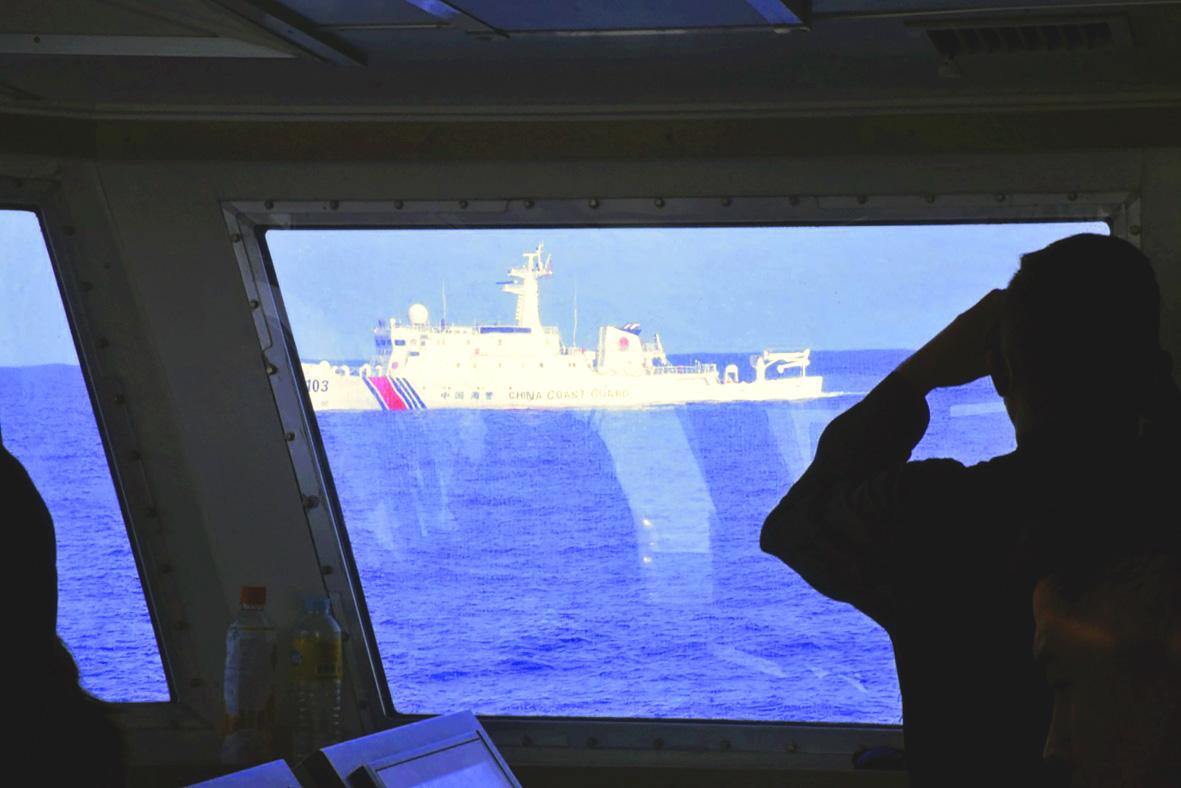A Chinese coast guard ship last month maneuvered for days near a research vessel deployed by Taiwanese and Philippine scientists to undertake a crucial survey of undersea fault lines west of the northern Philippines, sparking concerns among the scientists on board, officials said yesterday.
From March 25 to Wednesday last week, the scientists on the R/V Legend proceeded with their research on the Manila Trench, near the northwestern Philippine city of Vigan, despite the presence of the Chinese coast guard ship in the vicinity.
The Chinese coast guard’s proximity sparked concerns because the research vessel was towing a survey cable in the sea, a Philippine scientist said.

Photo: Philippine Coast Guard via AP
The ongoing offshore survey — a joint project of National Central University in Taiwan and the University of the Philippines’ National Institute of Geological Sciences — aims to help map offshore faults and other geologic features that could set off earthquakes, tsunamis and other potentially catastrophic hazards in the region.
The research, which ends on Wednesday next week, is partly funded by the Philippine Department of Science and Technology.
The Chinese coast guard ship maneuvered within 2 to 3 nautical miles (3 to 5km) of the R/V Legend for several days, Carla Dimalanta of the National Institute of Geological Sciences said.
“Its proximity to the research vessel was cause for concern, especially when the research vessel was towing a streamer cable for the scientific measurements that were being done,” Dimalanta said in an e-mail.
She did not say whether the Chinese coast guard ship warned the research vessel that it had illegally entered Chinese territorial waters and should immediately move away
The Chinese coast guard has often issued this radio warning to foreign ships and vessels cruising near its outposts in the South China Sea, which Beijing claims virtually in its entirety.
For decades, Taiwan, Brunei, China, Malaysia, the Philippines and Vietnam have been locked in an increasingly tense territorial standoff in the South China Sea.
The Manila Trench, which runs off the western coast of the main northern Philippine island of Luzon on the edge of the South China Sea has long been an area of concern because of the potential disaster it could unleash if a major earthquake and tsunami were generated in the busy waterway that borders several countries, including Taiwan, China and the Philippines.
Two officers said on condition of anonymity that the Philippine military was aware that the Chinese coast guard had been tracking the research vessel.
There was no immediate comment from Chinese embassy officials in Manila.
Late last month, the Philippine coast guard said that Chinese coast guard ships maneuvered dangerously close to its patrol ships at least four times in the vicinity of the disputed Scarborough Shoal (Huangyan Island, 黃岩島) off the northwestern Philippines over the past year.
The movement of the Chinese coast guard ships increased the risk of collision and contravened international safety regulations, the Philippine coast guard said at the time.
In one of those dangerous movements, a Chinese coast guard ship moved just 20m from a Philippine coast guard vessel and restricted its maneuvering space in the vicinity of the Scarborough Shoal in a “clear violation” of a 1972 international safety regulation that aims to prevent sea collisions, said the Philippine coast guard, which reported the incident to the Philippine Department of Foreign Affairs.
China’s seizure of Scarborough Shoal prompted the Philippines to bring the dispute to international arbitration.
In 2016, a UN-backed tribunal invalidated most of China’s claims and said it has contravened the rights of Filipinos to fish at the shoal.
China dismissed the ruling as a sham and continues to defy it, but has allowed Philippine fishers to return to the shoal under Philippine President Rodrigo Duterte’s administration, which has nurtured closer ties with Beijing.
Despite the two countries’ closer relations, sporadic territorial spats have persisted.
Two weeks ago, US Indo-Pacific Commander Admiral John Aquilino told reporters on board a US Navy reconnaissance aircraft that China has fully militarized three of the seven islands that it built in the disputed Spratly Islands (Nansha Islands, 南沙群島) in the South China Sea, arming them with anti-ship and anti-aircraft missile systems, laser and jamming equipment, and military aircraft in an increasingly aggressive move that threatens all nations operating in the disputed waters.
China said that its deployment of “necessary national defense facilities on its own territory is a right entitled to every sovereign country and is in line with international law, which is beyond reproach.”

REVENGE: Trump said he had the support of the Syrian government for the strikes, which took place in response to an Islamic State attack on US soldiers last week The US launched large-scale airstrikes on more than 70 targets across Syria, the Pentagon said on Friday, fulfilling US President Donald Trump’s vow to strike back after the killing of two US soldiers. “This is not the beginning of a war — it is a declaration of vengeance,” US Secretary of Defense Pete Hegseth wrote on social media. “Today, we hunted and we killed our enemies. Lots of them. And we will continue.” The US Central Command said that fighter jets, attack helicopters and artillery targeted ISIS infrastructure and weapon sites. “All terrorists who are evil enough to attack Americans are hereby warned

‘POLITICAL LOYALTY’: The move breaks with decades of precedent among US administrations, which have tended to leave career ambassadors in their posts US President Donald Trump’s administration has ordered dozens of US ambassadors to step down, people familiar with the matter said, a precedent-breaking recall that would leave embassies abroad without US Senate-confirmed leadership. The envoys, career diplomats who were almost all named to their jobs under former US president Joe Biden, were told over the phone in the past few days they needed to depart in the next few weeks, the people said. They would not be fired, but finding new roles would be a challenge given that many are far along in their careers and opportunities for senior diplomats can

Seven wild Asiatic elephants were killed and a calf was injured when a high-speed passenger train collided with a herd crossing the tracks in India’s northeastern state of Assam early yesterday, local authorities said. The train driver spotted the herd of about 100 elephants and used the emergency brakes, but the train still hit some of the animals, Indian Railways spokesman Kapinjal Kishore Sharma told reporters. Five train coaches and the engine derailed following the impact, but there were no human casualties, Sharma said. Veterinarians carried out autopsies on the dead elephants, which were to be buried later in the day. The accident site

RUSHED: The US pushed for the October deal to be ready for a ceremony with Trump, but sometimes it takes time to create an agreement that can hold, a Thai official said Defense officials from Thailand and Cambodia are to meet tomorrow to discuss the possibility of resuming a ceasefire between the two countries, Thailand’s top diplomat said yesterday, as border fighting entered a third week. A ceasefire agreement in October was rushed to ensure it could be witnessed by US President Donald Trump and lacked sufficient details to ensure the deal to end the armed conflict would hold, Thai Minister of Foreign Affairs Sihasak Phuangketkeow said after an ASEAN foreign ministers’ meeting in Kuala Lumpur. The two countries agreed to hold talks using their General Border Committee, an established bilateral mechanism, with Thailand